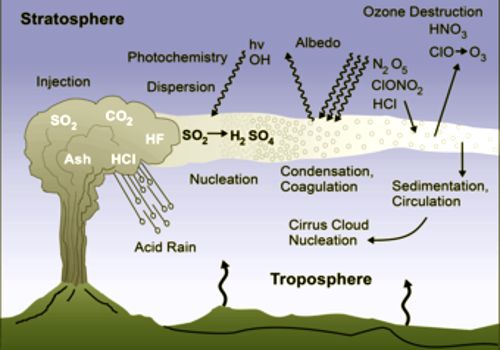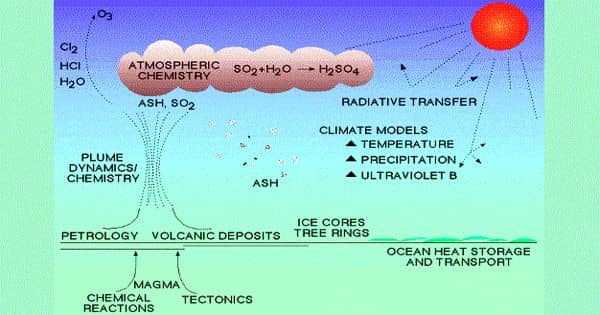Volcanic ash may decrease Carbon Dioxide also Climate Change
Volcanic eruptions can affect climate in two main ways. First, they release the greenhouse gas carbon dioxide, contributing to the warming of the atmosphere. Second, sulphur dioxide contained in the ash cloud can produce a cooling effect. A team from the University’s School of Ocean and Earth Science has modeled the impact of spreading volcanic ash from a ship to an area of the ocean floor to help amplify natural processes that lock away CO in the seabed. The characteristics of the ash cloud largely determine whether a volcanic eruption influences the climate or not. They found the technique has the potential to be cheaper, technologically simpler, and less invasive than other techniques to remove harmful gases. Volcanic eruptions are responsible for releasing molten rock, or lava, from deep within the Earth, forming new rock on the Earth’s surface. But eruptions also impact the atmosphere.
Human-caused climate change is one of the most pressing topics in contemporary science and politics. The impact of hundreds of years of greenhouse gas emissions are becoming clearer every year, with environmental changes including heatwaves, droughts, wildfires, and other extreme weather events. It’s not just the spectacular eruptions that can affect the climate. Recent research has suggested that even small eruptions could be contributing to slower surface temperature rise in the last 15 years or so, compared to previous decades.
University of Southampton scientists investigating ways of removing carbon dioxide (CO2) and other greenhouse gases from our atmosphere believe volcanic ash could play an important role. “As a result of overwhelming evidence, politicians have begun to take steps towards incorporating emissions reductions into policies, such as in the 2015 Paris Agreement with its long-term goal of ensuring that global average temperatures do not exceed 2°C above pre-industrial levels.” Explains study co-author and University of Southampton Professor of Geochemistry, Martin Palmer. A team from the University’s School of Ocean and Earth Science has modeled the impact of spreading volcanic ash from a ship to an area of the ocean floor to help amplify natural processes that lock away CO2 in the seabed.
Volcanoes also release large amounts of greenhouse gases such as water vapor and carbon dioxide. GGR techniques remove carbon dioxide and other gases from the atmosphere, thereby reducing the greenhouse effect, and in the longer term, slowing climate change. The amounts put into the atmosphere from a large eruption doesn’t change the global amounts of these gases very much. There are numerous potential approaches to GGR, from the simple, such as reforestation, to the complex, such as actively removing CO2 from the atmosphere.

Fig: Volcanoes Can Affect Climate
The gases and dust particles are thrown into the atmosphere during volcanic eruptions have influences on climate. Most volcanoes lie close to the oceans, and every year millions of tonnes of volcanic ash fall into them and settle to the seafloor. Most of the particles spewed from volcanoes cool the planet by shading incoming solar radiation. The cooling effect can last for months to years depending on the characteristics of the eruption. Once there, it increases carbon storage in marine sediments and reduces atmospheric CO2 levels. This is important because the oceans are the greatest sink of humanmade CO2 on Earth. Volcanoes have also caused global warming over millions of years during times in Earth’s history when extreme amounts of volcanism occurred, releasing greenhouse gases into the atmosphere.
The scientists modeled the effect of distributing volcanic ash from a ship to an area of ocean. Even though volcanoes are in specific places on Earth, their effects can be more widely distributed as gases, dust, and ash get into the atmosphere. The results suggest that this method could sequester as much as 2300 tonnes of CO2 per 50,000 tonnes of ash delivered for a cost of $50 per tonne of CO2 sequestered — much cheaper than most other GGR methods. In addition, the approach is simply an augmentation of a naturally occurring process, it does not involve expensive technology and it does not require repurposing valuable agricultural land.
Volcanoes can impact climate change. During major explosive eruptions, huge amounts of volcanic gas, aerosol droplets, and ash are injected into the stratosphere. The scientists say further research is needed though to test the efficiency of enhanced ash deposition in the oceans and to make sure there are no unforeseen side effects, but initial indications suggest that it could be applied easily and cheaply in many areas of the world. There continue to be efforts to reduce uncertainties and improve estimates of present-day global volcanic CO2 emissions, but there is little doubt among volcanic gas scientists that the anthropogenic CO2 emissions dwarf global volcanic CO2 emissions.















